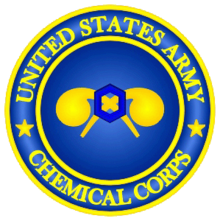Chemical Corps
This article or section is in a state of significant expansion or restructuring. You are welcome to assist in its construction by editing it as well. If this article or section has not been edited in several days, please remove this template. If you are the editor who added this template and you are actively editing, please be sure to replace this template with {{in use}} during the active editing session. Click on the link for template parameters to use.
This article was last edited by IvoShandor (talk | contribs) 16 years ago. (Update timer) |

The Chemical Corps is the branch of the United States Army that has the mission to protect the force from Chemical, Biological, Radiological, and Nuclear (CBRN) weapons. Founded as the Chemical Warfare Service in WW1, it became the Chemical Corps in 1946.
History
Early history
The earliest predecessors to the United States Army Chemical Corps owe their existence to the changing of military technology, through the use of poison gas, early in World War I. The United States War Department's first interest in providing individual soldiers with personal protection against chemical warfare came in 1915 and they tasked the Medical Department with developing the technology. Despite this early interest, troops were neither supplied with masks nor trained for offensive gas warfare until the U.S. became involved in World War I in 1917.[1] By 1917 use of chemical weapons by both the Allied and Central Powers had become commonplace along the Western, Eastern and Italian Fronts, occurring daily in some regions.[2] In 1917, Secretary of the Interior Franklin K. Lane, directed the Bureau of Mines to assist the Army and Navy in creating a gas war program. After the Director of the Bureau of Mines formally offered the bureau's service to the Military Commitee of the National Research Council, the council appointed a subcommittee on noxious gases.[1]
Chemical Warfare Service
After World War I and before World War II, referred to as the "interwar period", the Chemical Warfare Service maintained its arsenal despite public pressure and presidential wishes in favor of disarmament. General Amos Fries, the CWS chief from 1920–29, viewed chemical disarmament as a Communist plot.[2] Through his leadership, the CWS and its various Congressional and independent allies were able to halt the U.S. Senate's ratification of the Geneva Protocol.[2]
Post World War II
Vietnam War
Organization and mission
The U.S. Army Chemical School is the home of the Army's Chemical Corps, located at Fort Leonard Wood, Missouri. The school is currently commanded by Brigadier General Thomas Spoehr, with CSM Patrick Alston is the Regimental Command Sergeant Major. There are approximately 22,000 members of the Chemical Corps in the U.S. Army, spread among the Active, Army Reserve, and Army National Guard.
The school trains officers and enlisted personnel in CBRN warfare and defense; its stated mission is "To protect the force and allow the Army to fight and win against an CBRN threat. Develop doctrine, equipment and training for CBRN defense which serve as a deterrent to any adversary possessing weapons of mass destruction. Provide the Army with the combat multipliers of smoke, obscurant, and flame capabilities."
Traditions

The Chemical Corps, like all branches of the U.S. Army, uses specific insignia to indicate a soldier's affiliation with the corps. The Chemical Corps branch insignia consists of a cobalt blue, enamel benzene ring superimposed over two crossed gold retorts. The branch insignia, which was adopted in 1917 by the fledgling Chemical Service, measures .5 inches in height by 1.81 inches in width. The Chemical Warfare Service approved the insignia in 1921 and in 1924 the ring adopted the cobalt blue enamel. When the Chemical Warfare Service changed designations to the Chemical Corps in 1946 the symbol was retained.[3]
The Chemical Corps regimental insignia was approved on May 2, 1986. The insignia consists of a 1.2 inch shield of gold and blue emblazoned with a dragon and a tree. The shield is enclosed on three sides by a blue ribbon with Elementis Regamus Proelium written around it in gold lettering. The phrase translates to: "Let us (or we) rule the battle by means of the elements". The regimental insignia incorporates specific symbolism in its design. The colors, gold and blue, are the colors of the Chemical Corps, while the tree's trunk is battle scarred, a reference to the historical beginnings of U.S. chemical warfare, battered tree trunks were often the only reference points that chemical mortar teams had across no man's land during World War I.[4] The tree design was taken from the coat of arms of the First Chemical Regiment. The dragon symbolizes the fire and destruction of chemical warfare, and its green color is meant to denote the first use of poison gas, chlorine, in combat.[3][4] Individual Chemical Corps soldiers are often referred to as "Dragon Soldiers".
Awards and notable soldiers
See also
Notes
- ^ a b Brophy, Leo P. "Origins of the Chemical Corp," (JSTOR), Military Affairs, Vol. 20, No. 4. (Winter, 1956), pp. 217-226. Retrieved 14 October 2007.
- ^ a b c van Courtland Moon, John Ellis. "United States Chemical Warfare Policy in World War II: A Captive of Coalition Policy?" (JSTOR), The Journal of Military History, Vol. 60, No. 3. (Jul., 1996), pp. 495-511. Retrieved 14 October 2007.
- ^ a b "Chemical Corps," Office of the Administrative Assistant to the Secretary of the Army, The Institute of Heraldry. Retrieved 14 October 2007.
- ^ a b "Regimental Crest," U.S. Army Chemical School, United States Army — Fort Leonard Wood. Retrieved 14 October 2007.
